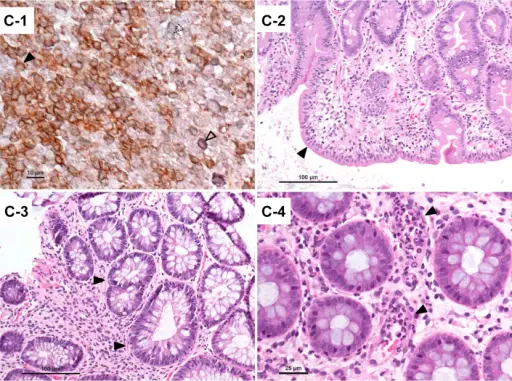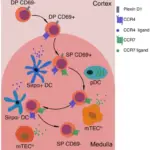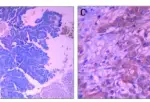
Clinical course of a familial autoimmunity syndrome caused by LRBA deficiency, immunohistochemical analysis of lymph node specimens (patient 1), and histologic assessment of gastrointestinal biopsy specimens (patient 2). A, Clinical course of a now 19-year-old girl, patient 1, including treatment and HSCT at the age of 10 years. B, Symptoms and treatment outline of patient 2. C,C.1, Triple immunohistochemical staining of T-cell markers showing increased double-negative T-cell numbers marked only with an antibody against CD3 (light blue/gray, dashed arrow), which is reminiscent of CD95 deficiency; CD4+ (brown, solid arrow) and CD8+ (purple, open arrow) T cells are also shown. C.2, Duodenal biopsy specimens showing focal villous flattening and intraepithelial lymphocytosis. C.3, Colon mucosa with moderate crypt distortion and sparse apoptotic bodies. C.4, Signs of vasculitis indicated by abundant neutrophilic granulocytes within and migrating through the lamina propria capillaries of the colon mucosa. Plasma cells were absent in all sections. AdV, Adenovirus; AIHA, autoimmune hemolytic anemia; ATG-F, anti-thymocyte globulin-Fresenius (Fresenius Medical Care, Vienna, Austria); AZT, azidothymidine; cITP, chronic immune thrombocytopenia; CsA, cyclosporin A; ENT, ear, nose, and throat; IVIG, intravenous immunoglobulin subsitution; LPD, lymphoproliferative disease; MFD-BMT, matched family donor bone marrow transplantation; MMF, mycophenolate mofetil; PEG tube, percutaneous enterogastral tube; TPN, total parenteral nutrition; SCIG, subcutaneous immunoglobulin subsitution; UTI, urinary tract infection.
Long-term remission after allogeneic hematopoietic stem cell transplantation in LPS-responsive beige-like anchor (LRBA) deficiency.
Seidel MG, Hirschmugl T, Gamez-Diaz L, Schwinger W, Serwas N, Deutschmann A, Gorkiewicz G, Zenz W, Windpassinger C, Grimbacher B, Urban C, Boztug K - The Journal of allergy and clinical immunology (2014). Not Altered. CC.
Causes of autoimmunity include susceptibility genes, breakdown of self-tolerance, environmental triggers, and infections. Defective tolerance. Defective regulation. Abnormal display of self-antigens. Inflammation. Initial innate immune response.
Defective tolerance is the inability to distinguish between self and non-self antigens, which leads to autoimmune diseases.
Defective regulation is the inability to control or restrain immune responses, resulting in either underreacting or overreacting to foreign invaders.
Abnormal display of self-antigens is the failure of self-tolerance mechanisms in T or B cells, resulting in an imbalance between lymphocyte activation and control.
Inflammation is a normal physiological defense against pathogen infection and tissue damage that resolves quickly. However, as a result of dysregulation, it may persist and cause significant tissue and organ damage.
Initial innate immune response is the first line of defense against invading pathogens and relies on the body’s ability to recognize pathogens.



